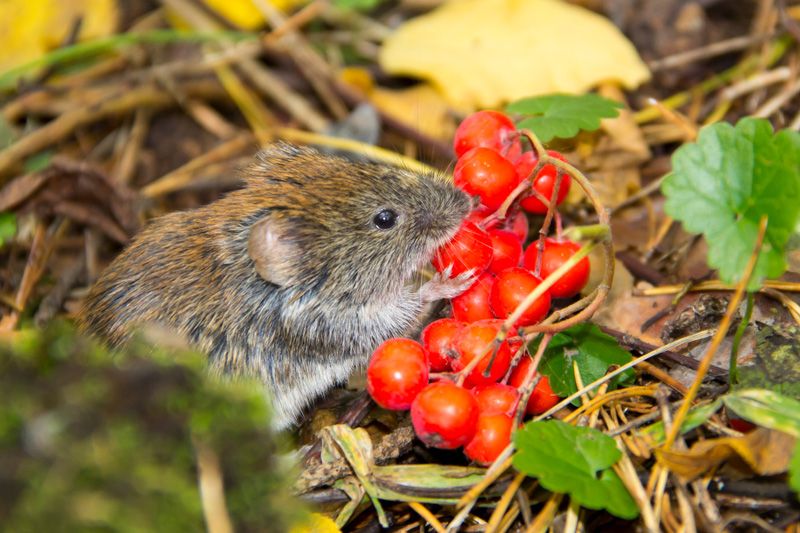
Vole
Vole
One of the biggest nightmares when it comes to gardening, is voles invasion. Rightfully so, since these rodents can destroy everything that comes in their way. This includes seeds, bulbs, tubers, fruits, and vegetables. They greatly resemble mice and other field rodents, both in appearance and damage. Hence, it is important to identify if the wreckage has been caused by voles, mice, or shrews. Voles, also known as field mice or meadow mice, are small, blunt-nosed rodents with a stocky body and grayish-brown fur.
Adult voles are larger than mice but smaller than rats, ranging in size from 4 to 6 inches. They reproduce quite rapidly, thus, they are one of the most abundant populations in North America. Unlike rabbits, voles feed throughout the day and not just during early or late hours, as a result increasing the intensity of damage. If you are still not sure about the suspicious intruder in your garden, check the burrows. Voles are known for their characteristic surface runways which appear as elevated ridges. Other garden critters, such as moles tunnel deep underground.
What attracts them to the garden?
Voles are exclusively outdoor rodents; living, feeding, and reproducing in burrows and tunnels. They are seen year round, chewing on your beloved crops, resulting in waste of time, money, and energy. However, there are a few reasons why voles may be particularly attracted to your garden. Let’s take a look.
Soft roots and bulbs
Voles love feeding on soft tubers, fruits, and roots, hence if you have a kitchen garden, we have some bad news for you. They are exclusive herbivores and feed on all types of plants, leading to decapitated flowers and gnawed fruits.
Weather conditions also have a significant impact on feeding habits. They attack the flowers and fruits during the warmer months, and resort to soft roots, tubers, and seeds during fall and winter.
Shelter and storage
Like all garden critters, voles are attracted to overgrown gardens, due to potential shelter under the weeds, mulch, and shrubs. They burrow tunnels under the grass and mulch and use it for transit as well as reproduction and food storage.
Thus, if you do not clear out your garden often, it is time you start removing the extra weeds and clutter regularly. This includes fallen leaves, debris, weeds, and mulch.
Water sources
Water sources such as ponds and tubs are another reason why garden critters, like voles, moles, rabbits, and chipmunks attack your garden.
Besides water sources, birdhouses with bird feeds and waterbaths also attract voles. The reason behind this is pretty clear. If the critters are getting food, water, and shelter all in one place, they would surely make themselves comfortable in your garden.
How to deter them away?
There is no denying that voles are extremely annoying garden pests. Fortunately, they are not hardy and can easily be eliminated or deterred with timely management. People in the past used to apply poisons on their plants to keep the voles away. However, this method is now obsolete due to its potential damage to your plants as well as animal cruelty.
Here are a few effective strategies to deter these garden critters and keep your plants safe.
Natural deterrents to keep them away:
Fencing
Most gardeners resort to fencing as the first option. Not only is it effective, but also does not require much investment and expertise. Make sure you install the fences at least 12 inches above and 6 inches below the soil since voles can burrow as well as climb. Non-rusting mesh and hardware cloth are solid options when it comes to fencing.
Vole traps
Live capture traps are a good investment if you have ample patience. They require waiting for the voles to get trapped, and then releasing them at least half a mile away from your garden. Since voles love fruits, you can use apples and bananas as bait and tie them on the traps. You can easily find vole traps in the markets; however, mouse traps work just fine.
Pest repellants
Spraying repellants on your crops is an excellent way to keep the voles away. The best part is that you can use natural pest repellants, made from household items. They work just as great as expensive chemical repellents.
Mix equal parts of castor oil and dishwashing soap in a gallon of water and spray the mixture on your plants as well as vole tunnels and trails. Make sure to do it once weekly for best results. Pepper flakes and dishwashing soap is another alternative that has shown remarkable success in keeping the voles away.
Premise of other deterrents
Remove weeds and mulch
One of the most common spots for voles is under the trees, beneath the mulch and snow. They hide under the mulch and feed on the roots without getting noticed. This is where habitat modification comes in handy.
Habitat modification means making your garden unappealing to the voles by removing anything from your garden that may provide accommodation to the voles. This includes weed, mulch, and overgrown grasses, as well as growing plants, like onion, mint, and castor beans that repel the voles.
Cover the crops
Covering your shrubs, trees, and bulbs with wire netting can protect your plants by not allowing the voles to chomp on them. You can also put propagator lids on seed trays and grow your bulbs in poultry baskets to conceal them from voles. Basically, you need to fence your crops individually and not just the outskirts of your garden.
Raised garden beds
Voles prefer burrowing over climbing. Hence, raised garden beds serve as an excellent option if you are seeing frequent vole attacks. Not only do they protect your crops, but also make an appealing addition to your garden. For added safety, cover the raised beds with fine mesh so the voles cannot reach the crops even if they climb the garden beds.
